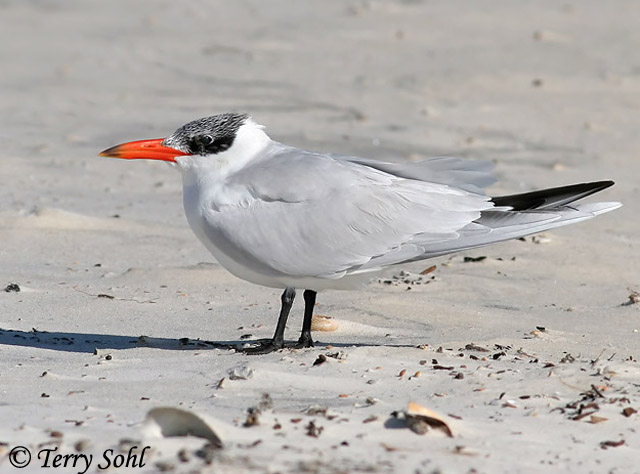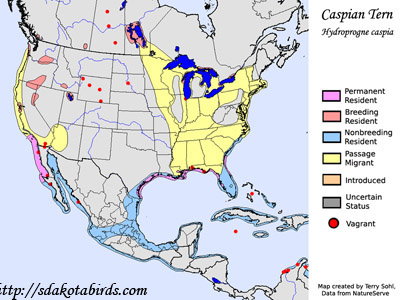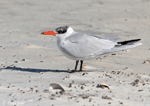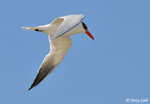| Length: 20 - 22 inches | Wingspan: 52 inches | Seasonality: Migrant |
| ID Keys: Large size, thick reddish-orange bill, black cap extending below eyes | ||
 Caspian Terns are the only large terns likely to be seen on
inland waters, including within South Dakota. Less sociable than many
terns, they are often seen singly or in small groups. Known for their
aggressive feeding tactics, Caspian Terns won't hesitate to steal a catch from
another bird, or raid a nesting colony for eggs and young birds. Young of
the species are dependent upon their parents for a much longer period of time
than most other terns and gulls, and can still be seen begging parents for food
in mid-winter.
Caspian Terns are the only large terns likely to be seen on
inland waters, including within South Dakota. Less sociable than many
terns, they are often seen singly or in small groups. Known for their
aggressive feeding tactics, Caspian Terns won't hesitate to steal a catch from
another bird, or raid a nesting colony for eggs and young birds. Young of
the species are dependent upon their parents for a much longer period of time
than most other terns and gulls, and can still be seen begging parents for food
in mid-winter.
Habitat: Prefers large expanses of water, including coastlines, large lakes, reservoirs, and large rivers.
Diet: Primarily feeds on fish. They often focus on just one or two primary prey species, which vary from location to location. They will also feed on large insects, eggs and young birds, and occasionally crustaceans or mollusks.
Behavior: Feeds by plunging into the water for prey after spotting it in flight. Very aggressive, they will often steal food from other bird species.
Nesting: June and July. The nest of a Caspian Tern is a shallow depression on the ground, sometimes lined with bits of vegetation or debris. The female usually lays between 1 and 3 eggs, and both parents help to incubate them. When the eggs hatch, both parents help to feed the y oung. Young fledge after about a month, but typically stay with the parents for several months after fledging.
Breeding Map: Only a very rare breeder in South Dakota. Breeding Bird Survey map unavailable.
Song: Caspian Tern Song
Migration: Summers along coastlines and in widely scattered inland locations throughout Canada and the United States. Inland birds move to coastlines in the winter, and wintering birds can be found southward through northern South America.
Interactive eBird Map: Click for access to an interactive eBird map of Caspian Tern sightings
Similar Species: In South Dakota, somewhat similar to Common Tern and Forster's Tern, but large size and heavy bill make it quite distinctive. Ini other parts of its range, most likely to be confused with Royal Tern.
Conservation Status: Numbers are generally stable, with some indications that it is increasing in both range and in numbers. The IUCN lists the Caspian Tern as a species of "Least Concern".
Further Information: 1) USGS Patuxent Bird Identification InfoCenter, Caspian Tern
3) Audubon Guide - Caspian Tern
Photo Information: February 13th, 2008 - Bon Secour National Wildlife Refuge, Alabama - Terry Sohl
Additional Photos: Click on the image chips or text links below for additional, higher-resolution Caspian Tern photos.
| Click on the map below for a higher-resolution view |
 |
| South Dakota Status: A rare migrant statewide, most commonly in the East and near the Missouri River. Only an accidental breeder, in the Northeast and along the Missouri River. |
Additional Caspian Tern Photos
Click for a higher-resolution version of these photos



